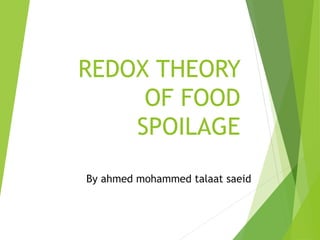
redox theory of food spoilage
- 1. REDOX THEORY OF FOOD SPOILAGE By ahmed mohammed talaat saeid
- 2. CONTENTS: a)definition b)Characters of food spoilage c)Types of food spoilage d)Redox theory e)Oxidation of food f)Factors affect redox on food g)Air and oxygen K)Effect of redox on microbial growth l)Mechanism of redox on microbial growth m)Prevention of oxidation of food spoilage n)refrences
- 3. spoilage The deterioration of food and other perishable goods Any change which renders a product unacceptable for human consumption Complex event in which a combination of microbial and biochemical activities may interact Disagreable change in a food’normal state
- 4. Characters of food spoilage: 1-unpleasant smell 2-unpleasant taste 3-colour change 4-texture change 5-mouldy
- 5. Types of food spoilage: • Microbial spoilage • Non- microbial spoilage • Based on rate of spoilage : there are three types Highly perishable :meat, fish, egg, milk, most fruits and vegetables Semi perishable : potatoes, some apple varities and nut meat Non-perishable or stable : sugar,flour and dry beans • Pharmaceutical spoilage
- 6. Pharmaceutical spoilage: -there are several factors that cause pharmaceutical spoilage physical chemical microbial Deterioration of pharmaceuticals due to physical factors like ,heat ,temperature ,evaporation,etc Deterioration of pharmaceuticals due to chemical reactions like,oxidation ,reduction, Hydrolysis, Ionization,etc Deterioration of pharmaceuticals due to contamination of any microbial cell like,bacteria,fungi ,moulds,etc
- 7. What is a redox reaction ? Redox- reduction + oxidation Both process occur simultaneously Hence, one species is oxidized ,another is reduced So, what is oxidation, and what is reduction? 3 different versions of the difinition
- 8. redox oxidation reduction Gain in oxygen Loss of oxygen Loss of hydrogen Gain in hydrogen Loss of electron Gain in electron
- 9. Oxidation of food :what a waste -fruits and vegetables oxidized when left in open air
- 10. Oxidation of… people! -oxidation of nutrients causes increased activity of cells, leading to aging skin
- 11. Factors affect redox on food i. Air ii.Light iii.oxygen
- 12. Air Oxidation, a chemical process that produces undesirable changes in color, flavor, nutrient content, results when air reacts with food components
- 13. light Light exposure could result in color and vitamin loss. light may be responsible for the oxidation of fats
- 14. light -oxidation of food Reversion flavor of soyabean Sunlight flavor in milk Rabid loss of riboflavin, vitamin D,E,C Greening of potato
- 15. oxygen Oxygen can also cause spoilage of foods spontaneously, by itself. oxidative spoilage is the chief cause of quality loss in fats and fatty portions of foods. When lipid oxidies, short chain carbon compound are formed ;these compounds have strong odors and flavors and are very undesirable and unacceptable.
- 16. Air and oxygen One important cause of food spoilage is air and oxygen. Because air is colorless, odorless, and tastless , it is often taken for granted and sometimes forgotten as a means to cause food to spoil. Air consists of 78%nitrogen, 21%oxygen, and 1%mixture of other gases. While oxygen is essential for life, it can have deteriorative effects on fats, and food colors, vitamins, flavors, and other food conistituents. Basically, oxygen can cause food spoilage in several ways. It can provide conditions that will enhance the growth of microorganisms; it can cause damage of foods with the help of enzymes; and it can oxidation.
- 17. Effect of redox potential on microbial growth Redox or oxireduction potential is defined as the sum of all oxidizing (dissolved oxygen, free radical, hydrogen peroxide, some oxidized metal ion…) and reducing (some vitamins, some reduced metal ions, thiol-containing molecules, hydrogen…)couples found in the medium. This means when the concentration of the oxidizing molecules increases the redox potential value of the medium increases but when the concentration of the reducing molecule increases the redox value of the medium decreases.
- 18. How can redox potential affect the growth of the microorganism? To rerspond this question we must keep in the head the relationship between the oxygen as oxidant found in the atmosphere and the redox potential. When microorganism found in aerobic medium (containing dissolved oxygen it means the medium is favourable for the growth of aerobic microorganisms which can use the oxygen as a final acceptor of electrons produced from the substrate via the metabolism. It is important to indicate here also that every microorganism possesses a favourable value of redox for growth. furthermore, It was reported that the redox potential value affects the pH intracellular of a microorganism, which form a component of the proton motive- forc. This effect was attributed to the change of the permeability of the cellular membrane, which increased by the decrease of the redox value of the medium.
- 19. The mechanism of the effect of the redox potential on the growth of the microorganisms a) Its effect on the structural composition of some sensitive-components/molecules found on the surface of the cell. These redox-sensitive components/molecules could be enzymes located in the surface of the cell, which its protein part (Apoenzyme) could be composed of sulfur-containing amino acids making it sensitive to the redox potential of the medium. Further more, the cofactors of these enzymes such as Fe, Zn, Mg, and Cu could be found in the oxidized or reduced form, which means the susceptibility of these metal ions to the redox potential of the substrate or/and the medium. b) If the energetic system of the cell (proton motive force) changes the ATP content of the cell will change which can affect many essential functions of the cell.
- 20. prevention of oxidation of food spoilage To forestall the effects of the oxidation, some doctors and scientists recommend antioxidants - Natural reducing agent such as vitamin C and vitamin E. the vitamin C in lemon juice can be used to prevent oxidizing on the cut surface of an apple, to keep it from turning brown. - Perhaps, Some experts maintain, natural reducing agents can also slow the pace of oxidation of the human body.
- 21. Thank you